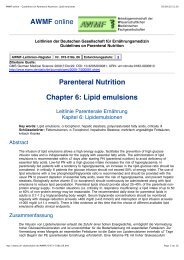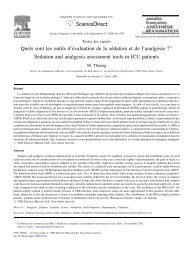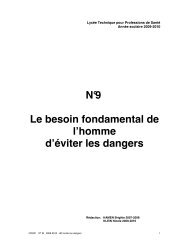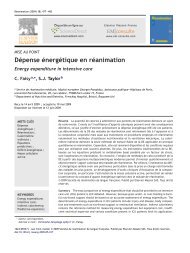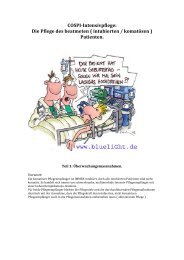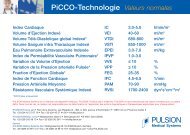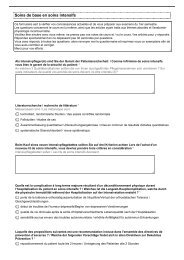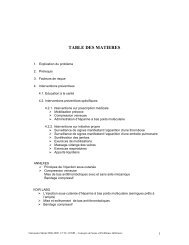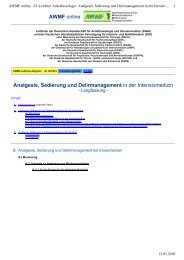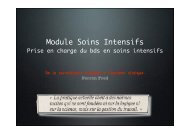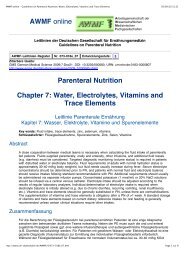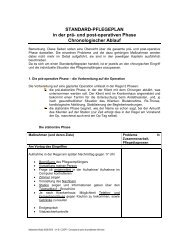Norton, Waterlow and Braden scores: a review of ... - Cardiff University
Norton, Waterlow and Braden scores: a review of ... - Cardiff University
Norton, Waterlow and Braden scores: a review of ... - Cardiff University
Create successful ePaper yourself
Turn your PDF publications into a flip-book with our unique Google optimized e-Paper software.
Tissue viability<br />
Introduction<br />
This paper is primarily concerned with answering the<br />
questions ‘are risk assessment scales (RASs) valid <strong>and</strong><br />
reliable’ <strong>and</strong> ‘which <strong>of</strong> these clinical judgement <strong>and</strong> RASs<br />
are superior’ The path to answering these related questions<br />
commences with an introduction to the subject area, then<br />
describes the three most common RASs. Other <strong>review</strong>s <strong>of</strong><br />
RASs are then described to show the gap in knowledge which<br />
this <strong>review</strong> explores. To evaluate validity the items included<br />
in RASs are next identified <strong>and</strong> how these are used to<br />
compute an overall score. Reliability is next addressed as<br />
RASs are normally completed not only more than once, but<br />
by more than one clinician. Evaluation explores validity,<br />
reliability <strong>and</strong> outcomes <strong>and</strong> studies evaluating RASs are next<br />
examined. How RASs are actually used <strong>and</strong> whether they are<br />
better than clinical judgement is next considered. Finally<br />
problems in comparing clinical judgement <strong>and</strong> RASs are<br />
stated <strong>and</strong> suggestions for new work <strong>of</strong>fered.<br />
Search strategy<br />
Cumulative index to nursing <strong>and</strong> allied health literature<br />
(CINAHL) was searched using medical subject headings<br />
(MeSH) keywords ‘pressure ulcer’(PU) <strong>and</strong> ‘risk assessment’<br />
for all papers 1960–May 2006 which gave 531 papers. Limiting<br />
to research or <strong>review</strong> papers gave 253. The earliest paper<br />
located was 1991 <strong>and</strong> there were further papers each subsequent<br />
year, with a trend <strong>of</strong> increasing numbers in later years. All<br />
available abstracts were read <strong>and</strong> assessed for relevance. Where<br />
no abstract was available the title was examined to determine<br />
the relevance. Full text papers that were evaluated to be<br />
relevant were obtained where possible. Additional papers that<br />
were known to the authors were also used.<br />
Inclusion criteria<br />
Papers that used quantitative methods to evaluate RASs. All<br />
papers that considered sensitivity, specificity, receiver operating<br />
characteristic, inter- <strong>and</strong> intra-observer reliability.<br />
Exclusion criteria<br />
Papers with no evaluation <strong>of</strong> RASs, for example papers<br />
employing a RAS within a trial where the validity, reliability<br />
or precision <strong>of</strong> the RAS was not evaluated. Editorials <strong>and</strong><br />
journalistic articles with no primary data were also excluded.<br />
Results<br />
Pressure ulcers are not a new phenomenon. The first<br />
reference to PUs by a nurse that the authors can find was<br />
Comparison between <strong>scores</strong> <strong>and</strong> clinical judgement<br />
in 1899 when Amy Hughes, a nursing sister, wrote a section<br />
in a medical book outlining PU prevention (Hughes 1899).<br />
She advocated vigorous massage <strong>of</strong> the buttocks, thought<br />
then to be appropriate, now thought to be a disastrous<br />
strategy. Dyson showed, in a sample <strong>of</strong> 200 patients, a 38%<br />
reduction in incidence <strong>of</strong> PUs in those who had not received<br />
massage (Dyson 1978). Doctors had discussed PUs earlier; a<br />
BMJ editorial in 1873 discussed PUs (Anonymous 1873),<br />
stating they should be left to dry out. This is also now<br />
thought to be the wrong approach, as Winter showed that<br />
sores heal much faster under an occlusive dressing (Winter<br />
1962). The same year James Paget gave advice on how to<br />
treat them that was surprisingly similar to modern ideas,<br />
advocating diet as being crucial (Paget 1873), though his<br />
prescription <strong>of</strong> restricting meat <strong>and</strong> giving a little wine<br />
would be seen as suboptimal today. However, there are<br />
earlier references; PUs were described in the sixteenth<br />
century by Pare (Levine 1992) <strong>and</strong> Fabricus (Torrance<br />
1983); Hildnaus used term decubitus in 1590 (Guggisberg<br />
et al. 1992); they have even been seen in Egyptian mummies<br />
(Torrance 1983).<br />
There are many papers on prevention <strong>of</strong> PUs, <strong>and</strong> several<br />
clinical guidelines are available from reputable agencies that<br />
<strong>of</strong>fer consistent <strong>and</strong> evidence based advice, e.g. the National<br />
Institute <strong>of</strong> Clinical Excellence (available from http://<br />
www.nelh.nhs.uk).<br />
One might imagine, given the long history <strong>of</strong> PUs <strong>and</strong> the<br />
current availability <strong>of</strong> quality advice, nurses would be very<br />
familiar with prevention <strong>of</strong> PUs, <strong>and</strong> PU prevalence would be<br />
very low. However, the scale <strong>of</strong> the problem is huge; the<br />
European Pressure Ulcer Advisory Panel study found an<br />
overall prevalence <strong>of</strong> PUs in hospital patients in Europe <strong>of</strong><br />
18%, depending on patient group <strong>and</strong> care environment<br />
(Clark et al. 2004).<br />
Why this remains the case is explicable for two related<br />
reasons:<br />
1 Nurses are not always knowledgeable about PU prevention;<br />
for example, one audit showed deficiencies in knowledge <strong>of</strong><br />
the staff <strong>and</strong> care given to prevent <strong>and</strong> manage PUs (Jones<br />
et al. 2003). Even in 2005, nurses in one Turkish study were<br />
still using massage <strong>and</strong> inflatable rings for PU prevention<br />
(Acaroglu & Sendir 2005), nearly 30 years after massage<br />
was generally considered dangerous <strong>and</strong> at least 20 after<br />
inflatable rings were similarly viewed. Inappropriate PU<br />
prevention advice was evident in the UK decades after it was<br />
widely discredited in the academic press (Anthony 1996).<br />
2 PU prevalence <strong>and</strong> incidence are under-reported <strong>and</strong> thus<br />
nurses may not be aware <strong>of</strong> the true scale <strong>of</strong> the problem<br />
(Gunningberg & Ehrenberg 2004). If the true scale <strong>of</strong><br />
the problem was evident nurses would presumably more<br />
Ó 2008 The Authors. Journal compilation Ó 2008 Blackwell Publishing Ltd 647




